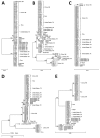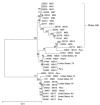Multilocus Sequence Typing Tool for Cyclospora cayetanensis
- PMID: 27433881
- PMCID: PMC4982147
- DOI: 10.3201/eid2208.150696
Multilocus Sequence Typing Tool for Cyclospora cayetanensis
Abstract
Because the lack of typing tools for Cyclospora cayetanensis has hampered outbreak investigations, we sequenced its genome and developed a genotyping tool. We observed 2 to 10 geographically segregated sequence types at each of 5 selected loci. This new tool could be useful for case linkage and infection/contamination source tracking.
Keywords: Cyclospora cayetanensis; molecular epidemiology; multilocus sequence typing; parasites; protozoa; whole genome sequencing.
Figures


References
-
- Hall RL, Jones JL, Herwaldt BL. Surveillance for laboratory-confirmed sporadic cases of cyclosporiasis—United States, 1997–2008. MMWR Surveill Summ. 2011;60:1–11. - PubMed
MeSH terms
Substances
LinkOut - more resources
Full Text Sources
Other Literature Sources

